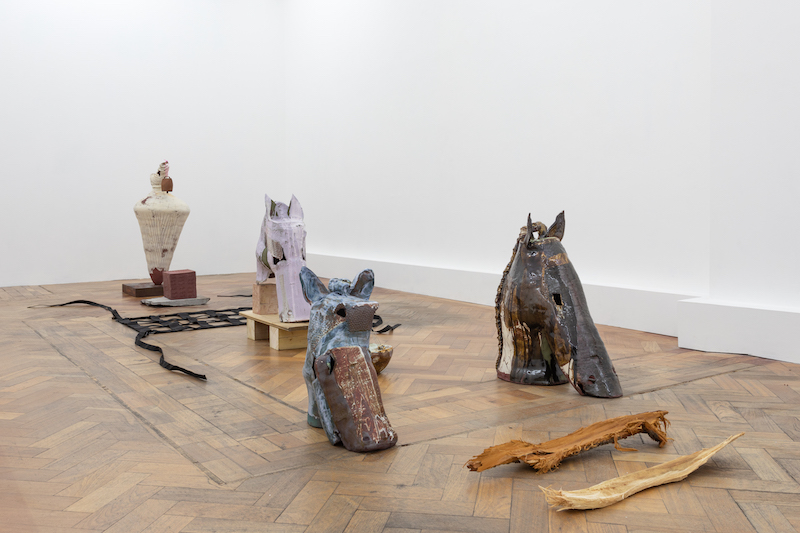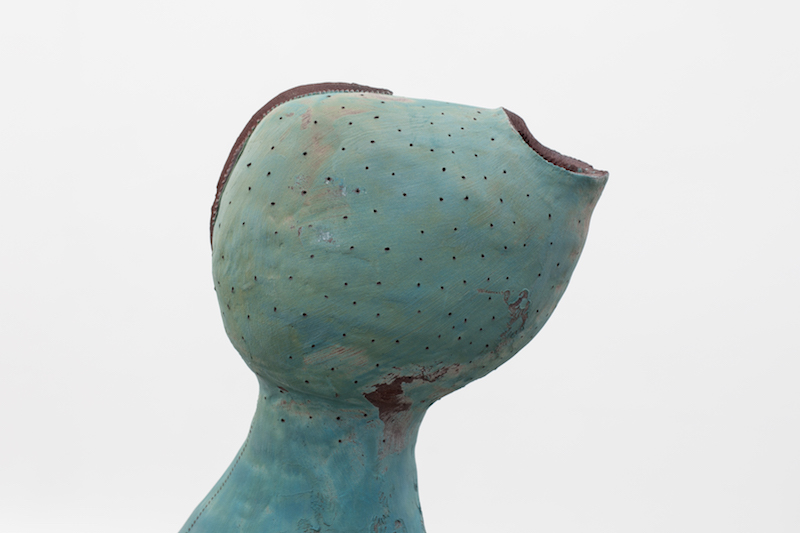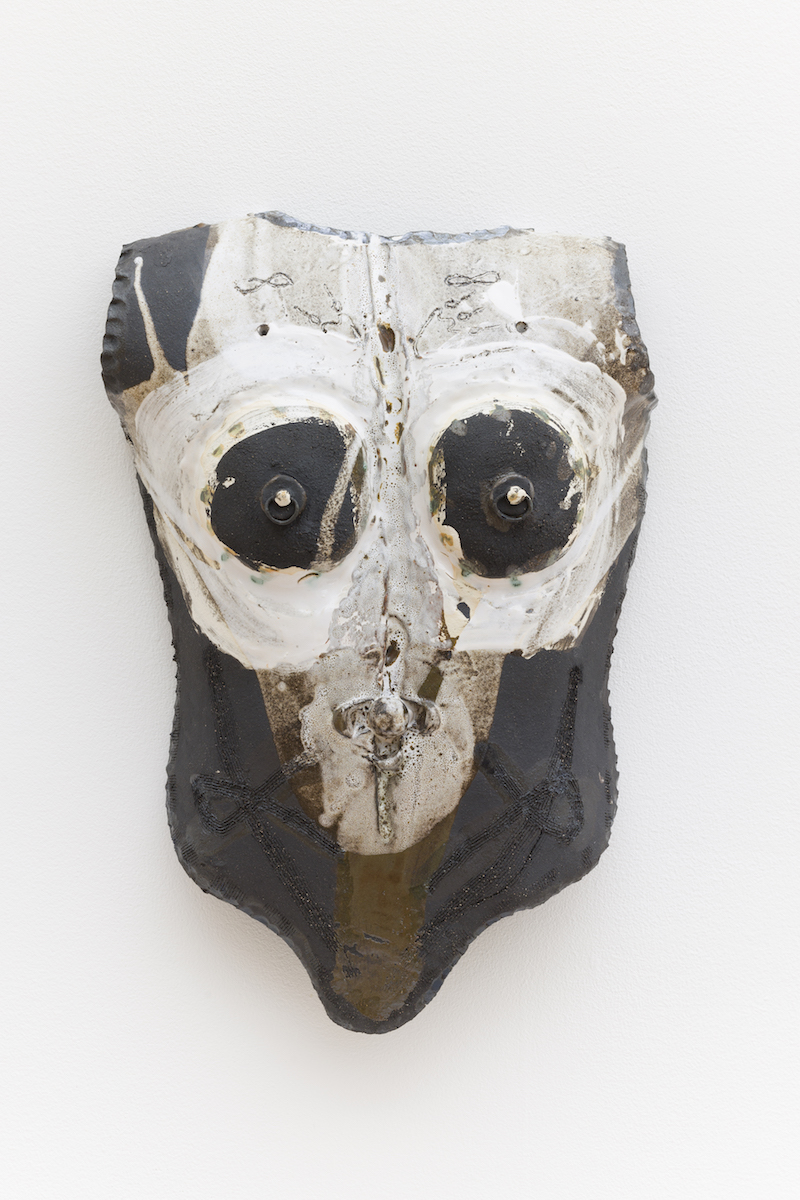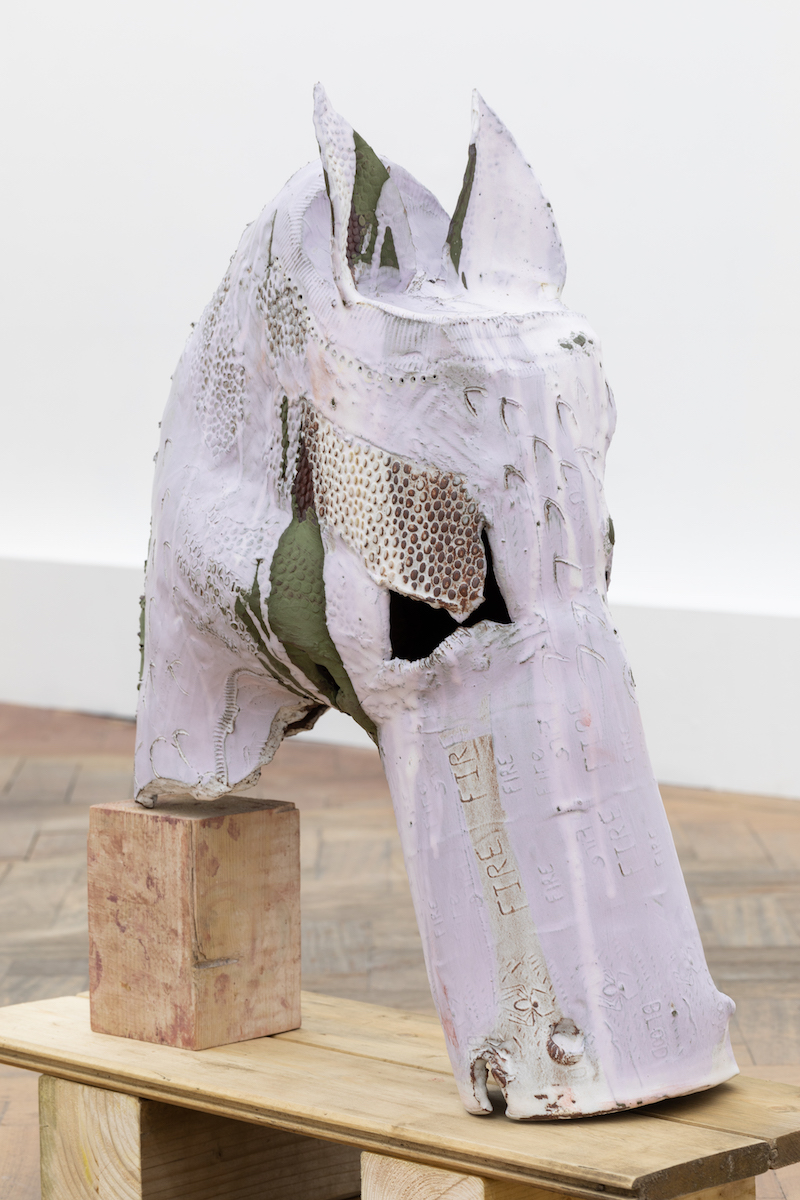by Nat Marcus // Nov. 28, 2023
This article is part of our feature topic Myth.
In a 2014 essay, Paul B. Preciado writes: “Every word in our language contains, as if rolled in on itself, a ball of time made up of historical actions. While the prophet and the politician try to make words sacred by covering up their historicity, the profane task of restoring sacred words to daily usage falls to philosophy and poetry: undoing the knots of time, wrestling words away from the conquerors in order to restore them to public space, where they can be the object of a collective re-signification.” An invitation to this re-signifying process has often been issued by the works of Phoebe Collings-James. The media may vary—from interleaved sound works of poems and field recordings to ceramic chest-plates gouged with words and inscriptions of traditional pottery motifs—but the playful imperative remains. And much like Preciado’s thinking of language as a “ball of time,” Collings-James has referred to clay as a material with memory, returning to contours and forms that adhere to its prior shaping, even after being fired.
Her most recent exhibition of ceramics at Arcadia Missa, ‘bun babylon; a heretics anthology,’ is animated with a lineage of Caribbean spiritual and political resistance. Through six serial works bearing titles with the weight of mythic archetypes (The Infidel, The Cypher, The Preacher, etc.) a tradition is at once honored, respirated and re-synthesised (and desacralised, made wavy in doing so).

Phoebe Collings-James: ‘bun babylon; a heretics anthology,’ installation view at Arcadia Missa, London // Photo by Josef Konczak, courtesy of the artist and Arcadia Missa, London
Nat Marcus: Your pieces called ‘The Infidel’—which were shown in the Arcadia Missa show—have a quality of being open-mouthed, and inasmuch as they are resonant and hollow vessels (one of them is even holding a bell), they seem capable of amplifying sound. With all that is going on in Palestine and Israel right now, it seems like people are starting to become infidels in the eyes of the art industry at the moment. In Germany, there is a growing issue in regard to which mouthpieces and voices are willing or allowed to say what. I know you’ve been involved in protesting for a ceasefire. What does this figure of ‘The Infidel’ mean to you right now?
Phoebe Colling-James: I think this moment is going to continue to reveal the ways that the art industry operates as a kind of vile satire. Museums and collectors will gobble up an artist’s work that discusses decolonisation and liberation, so long as they don’t have to do anything about it. I know galleries are getting calls on a daily basis from collectors who are furious about artists vocally supporting a ceasefire. And it seems like a sick joke, because three years ago everyone was posting a black square.
The show’s title signals to Babylon and the idea of a heretic, an outsider, someone who speaks at or into a crumbling system. Maybe it’s my way of processing the unrelenting violence, pressure and dystopia of this world. The final month of the show was throughout October, which was a chilling time to think about these works that articulate a spiritual position of resistance. ‘The Infidel,’ in particular, is speaking out, but it is still a spiritual figure—someone who has been displaced from a dogma, and not only a protestor or someone speaking truth to power. If someone doesn’t follow suit with certain State-led ideas of spirituality, they are often bound to be cut out, or cut themselves out, of an acceptable mode of society. The rounded bodies of these pieces suggest that they could roll over, show different sides, be in movement as a mode of defying static, unyielding positions.

Phoebe Collings-James: ‘The Infidel (detail),’ 2023, stoneware slip ceramic on a steel base, 88 x 38 cm // Photo by Josef Konczak, courtesy of the artist and Arcadia Missa, London
NM: The idea of movement carries in the layout of the show, as well. At your last solo in the Camden Arts Centre there was a mix of wall-mounted, hanging and grounded pieces, for instance, but this exhibition really feels like a procession. And there’s a sense of kinetics there. Maybe because of ‘The Guardian’ horse figures, it reminds me of ancient Roman funerary rites. The line between mythic and mortal was very porous in these ritual choreographies.
PCJ: There was always an intention for it to be a procession or parade, and for it to be seen in multiple ways. It could be a death march, a marching to war, a carnival procession. There is a sense of a gathering of characters, of entities, that are going to create something through the force of them being together. That’s why it felt important to have these supporting characters like the pieces of torn tree bark, slate and cargo net—these things that could bind the ritual.
NM: Do you have a spiritual practice of your own?
PCJ: I do have a spiritual practice, but not a religious practice. And I’m often trying to find ways of articulating that within my work. I bring in many references to Rastafarian and Jamaican music—artists like Midnite and Ranking Ann and Barrington Levy (whose song ‘Black Roses’ figured into ‘bun babylon’). This revolutionary music is deeply spiritual as well, which I’ve been thinking about in regard to myth-making. Even scriptural texts are meant to continue to grow with us, make themselves available for reference and reassessment. It comes back to the idea of movement, and how we work with a spiritual or unseen realm to create and understand ourselves through engaging with myth.

Phoebe Collings-James: ‘The subtle rules the dense,’ 2021, glazed ceramic, 57 x 39 x 14 cm // Photo by Rob Harris, courtesy of the artist and Arcadia Missa, London
NM: It has to do somehow with these very charged, often-instrumentalised relations between history, myth and memory, and how certain structures of authority try to calcify their connections. You are often sampling, drawing in many different strands and fragments of discourse from various places, and then metabolising it all through an artistic process. To me, that is a way of refurbishing myths, keeping them limber or relevant for us to make sense of our lives. The works in ‘bun babylon’ are described in the press release as “imbued with the potential for dissent.” When you work on these pieces, do they become imbued simply through your process, or is there a spiritual aspect of giving something over to them? Or are they one and the same thing?
PCJ: They’re not necessarily one and the same. Maybe it’s best to foreground by saying there are certain moments that I particularly connect with my work. Some days in the studio feel a bit administrative, but then there are these quieter moments when I retreat into myself, simultaneously connecting to the concepts and ideas of the work, the material and the firing process of the kiln. And what follows is a choreography—bringing these pieces together into relation—which reminds me of working with things like tarot.
NM: There are multiple registers of alchemy going on, from the discursive and cultural to the physical firing of the ceramics. And, alchemically, the show at Arcadia Missa feels very tarot, as it stages this parade of archetypes.
PCJ: I’m often thinking about the way these archetypes shift. The horse, the preacher, the bell and the bow harp: like tarot cards, they can all have different faces, varied meanings in relation to your own life. The reading of the cards is what creates the myth or instruction. This consideration extends to my own life and the myths that run through it.
A few weeks ago, my great aunt passed away and we recently had her funeral. My family is Jamaican, and they wear red or wrap red textiles around them for the ceremony, especially around babies, because that is understood to keep obeah away. It’s a symbol of protection. I enjoy thinking about how the many symbolic meanings of something like a colour are collapsed and resurrected and shape-shift across cultures.

Phoebe Collings-James: ‘The Guardian,’ 2023, stoneware ceramic, 56.5 x 33 cm // Photo by Josef Konczak, courtesy of the artist and Arcadia Missa, London
NM: You’ve sometimes spoken of a certain dichotomy between hardness and softness in your work, physically and sometimes emotionally. But then there is, of course, this discursive malleability that you are evoking through your work. It’s akin to trembling thinking and archipelagic thinking, articulated by Glissant: there is a resistance to the stilling or hardening of meaning, an excitement with not necessarily the arbitrariness of these archetypes but the fact that their character only comes into being in relation to other things.
PCJ: I find that liberating, that you can build this whole world of meaning, and then take it apart and play with the pieces. It is why I speak about detritus, emotional and material detritus. I’m interested in the fragments and details of our lives. The mess. This gives us the potential for imagining and re-imagining what life could be, what being could be. And, materially, through exhibition-making, I work intuitively with restriction, to temper this mess and also evoke the kind of restraint that is necessary for my own survival. To take the figure of the horse: in relation to ‘The Guardian’ works, I was thinking a lot about the story of the 4 horsemen of the apocalypse, in the ‘Book of Revelations.’ And in considering what these riders were supposed to represent—war, famine, death and conquest—I started thinking about their horses as potentially unconsenting conduits for these huge ideas, which were also supposed to be spontaneous catastrophes. Those connections are vividly held within the material decisions for the form and surface of the works. However, in framing my language for the show, I choose to remove this reference—to simply call these horses ‘Guardians’—and see where people’s own imaginations and associative connections take them.




















